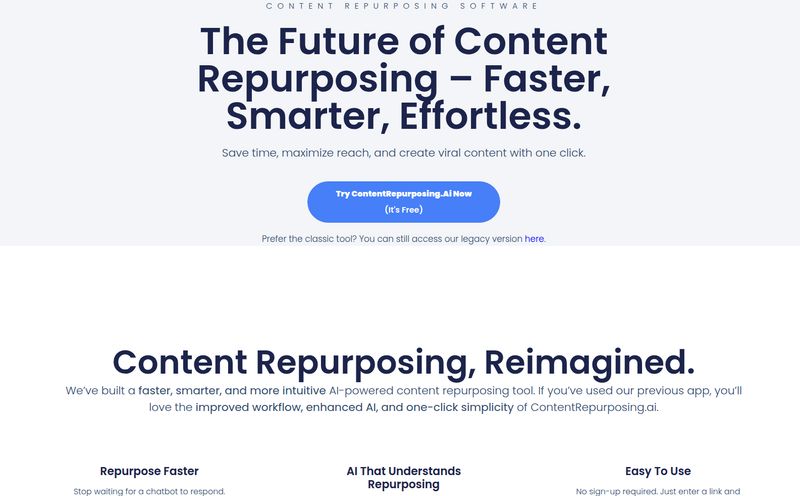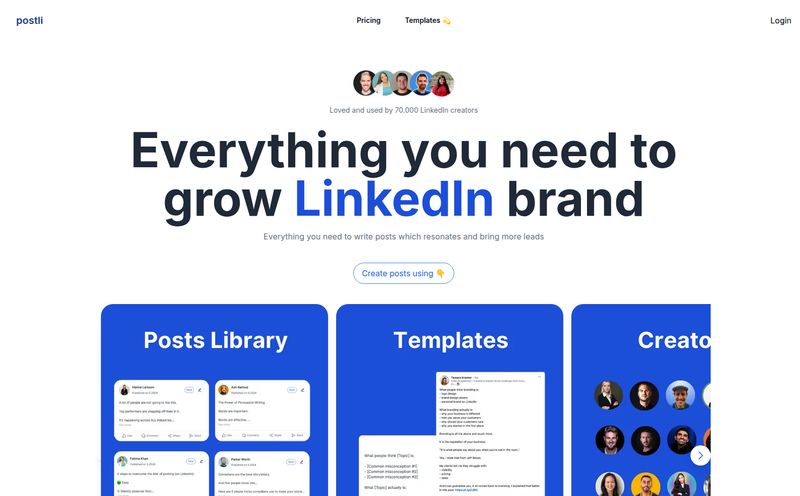You ever get that little thrill? You’re scrolling through Product Hunt or a niche marketing subreddit, and you stumble upon a new tool. A tool that promises to solve that one annoying, time-sucking problem that’s been plaguing you. For me, as a blogger who lives and dies by traffic and engagement, that problem is often the sheer, mind-numbing task of making long articles… well, readable.
So when I first heard whispers of a tool called BlogBoost, my interest was piqued. The pitch was seductive: an AI that automatically formats your long-form content, transforming dense walls of text into something beautiful and engaging. It sounded like magic. A shortcut to better user metrics. I went to check it out, eager to see the future. And I was greeted by this:
404: NOT_FOUND. Code: 'DEPLOYMENT_NOT_FOUND'.
A digital dead end. A ghost in the machine. So what was this thing? A flash in the pan? A brilliant idea that never got off the ground? Let’s put on our detective hats and dig into what BlogBoost promised, what went wrong, and what we can learn from this little tech mystery.
What Was BlogBoost Supposed to Be?
From the digital breadcrumbs I could find, BlogBoost was designed to be a blogger's best friend. Its entire purpose was to tackle the 'wall of text' syndrome. You know what I’m talking about. You spend hours, maybe even days, crafting a 2,000-word masterpiece, only to see your analytics show an average time on page of 30 seconds and a bounce rate higher than a kangaroo on a trampoline.
It hurts. The problem often isn’t the quality of your words, but the presentation. A monolithic block of text is intimidating. It’s a visual desert. The reader’s eye scans it, finds no oasis, no resting place, and promptly clicks the back button. BlogBoost aimed to be that oasis-maker. Using AI, it would intelligently add formatting like:
- Strategic bolding and italics to emphasize key points.
- Breaking up long paragraphs.
- Inserting blockquotes for impactful statements.
- Creating lists to make information digestible.
The goal was simple: make the content scannable, engaging, and professional-looking, all without the tedious manual labor.
The Allure of AI-Powered Formatting
I’ll admit, the idea is fantastic. As someone who has manually formatted thousands of articles, the thought of an AI doing the heavy lifting is incredibly appealing. Think about the potential benefits here. It’s not just about making things look pretty.

Visit BlogBoost
The Dream: Turning Visitors into Engaged Readers
When content is easier to read, people actually read it. Shocking, I know. This means they stay on your page longer, which sends a powerful positive signal to Google. Improved time on page and lower bounce rates are SEO gold. This is the core promise of a tool like BlogBoost. It’s not just a formatting tool; it’s an engagement tool. By simplifying complex ideas and presenting them clearly, you build trust with your audience. They feel smart, they feel respected, and they're more likely to see you as an authority, come back for more, and maybe even buy something from you.
A well-presented article just feels more credible. It’s the difference between a meticulously organized research paper and a bunch of frantic notes scrawled on a napkin. Same information, totally different impact.
But Let's Be Real: The Pitfalls of Automated Formatting
Now, I’ve been in this game long enough to know there's no such thing as a magic bullet. For every amazing promise a new AI tool makes, there's usually a footnote. Based on the cons I managed to dig up and my own experience with similar AI platforms, the reality of BlogBoost probably had a few rough edges.
The "Garbage In, Garbage Out" Principle Still Applies
Here’s the thing: an AI formatter can’t fix a fundamentally bad article. If your writing is vague, your arguments are weak, or your research is shoddy, no amount of bold text is going to save you. AI can put lipstick on a pig, but it’s still a pig. The effectiveness of a tool like this is always, always dependent on the quality of the source material. You still have to do the hard work of writing something worth reading.
AI Isn't a Mind Reader (Yet)
Another issue is nuance. AI is getting scarily good, but it can still miss the subtle context, tone, or ironic turn of phrase that a human writer intended. I can easily see a situation where an AI like BlogBoost would bold the wrong word in a sentence, completely changing its meaning, or break a paragraph at a really awkward spot, disrupting the flow. This means you'd still need a human review process, a final pass to smooth out the AI’s quirks. So it's a time-saver, not a replacement for a good editor.
So, What Happened to BlogBoost?
This brings us back to the 404 error. The digital graveyard is filled with promising startups. The 'DEPLOYMENT_NOT_FOUND' error, with its little `fra1` ID tag (a Vercel server in Frankfurt, for my fellow nerds), suggests this was likely a project hosted on a modern platform like Vercel that simply... stopped.
Did the developer run out of funding? Was it a side project that got abandoned? Was it acquired by a larger company and quietly shuttered? We may never know. It’s a quiet reminder that in the fast-paced world of SaaS, amazing tools can appear and vanish overnight. It’s why I always tell junior SEOs not to get too attached to any single piece of software, but to focus on the underlying principles instead.
Lessons Learned from a Ghost Tool
Even with BlogBoost gone, the idea behind it is more relevant than ever. Google's algorithms are increasingly focused on user experience. How a user feels when they interact with your content matters for your rankings.
You don’t need an AI to do this for you. You can be your own BlogBoost. Just follow the classic rules of web readability that experts like the Nielsen Norman Group have been talking about for years:
- Short Paragraphs: Keep them to 3-4 sentences, max.
- Subheadings: Use H2s and H3s to break up topics and guide the reader.
- Lists: Use bulleted or numbered lists for, well, lists of things.
- Visuals: Add images, charts, or videos to break up the text.
- Emphasis: Use bold and italics sparingly to make key terms pop. Don’t overdo it!
It takes a few extra minutes per article, but I promise you, it pays dividends in engagement and, ultimately, in traffic.
Frequently Asked Questions about AI Content Formatting
What is AI text formatting anyway?
It's the use of artificial intelligence to automatically analyze a piece of text and apply formatting—like bolding, lists, and paragraph breaks—to improve its readability and visual appeal without manual intervention.
Can AI formatting replace a human editor?
No, not completely. In my opinion, AI is a fantastic assistant but it lacks the nuanced understanding of context, tone, and flow that a human editor provides. It’s best used as a first-pass tool to save time, followed by a human review.
How does text formatting affect SEO?
Indirectly but powerfully. Good formatting improves user experience metrics like time on page and bounce rate. When people stay on your site longer, it signals to Google that your content is valuable, which can positively influence your search rankings.
Are there any alternatives to BlogBoost?
Yes, while BlogBoost seems to have vanished, other tools have features that can help. AI writing assistants like Jasper or Copy.ai often have templates that produce well-formatted content from the start. Even tools like Grammarly are getting better at suggesting formatting improvements for clarity.
What really happened to the BlogBoost website?
The specific 'DEPLOYMENT_NOT_FOUND' error suggests the application code was removed or the project was deleted from its hosting platform, like Vercel. It could be for any number of reasons from a failed business to a simple developer decision to move on.
Was BlogBoost free?
There's no public pricing info available, which often means the tool was in an early beta testing phase or was intended to be a free or freemium product to gain traction. The lack of a subscription model might have contributed to its disappearance.
Final Thoughts on the BlogBoost Mystery
So, R.I.P. BlogBoost. You were a great idea, maybe even a great tool for a fleeting moment. Your story is a classic Silicon Valley tale, a reminder of the brilliant ideas that flicker and fade. But the lesson you leave behind is a solid one: don’t bore your readers! Whether you use an AI assistant or just your own common sense, take the time to format your work. Your audience—and your Google rankings—will thank you for it.
Reference and Sources
- Google Search Central. "Creating helpful, reliable, people-first content." https://developers.google.com/search/docs/fundamentals/creating-helpful-content
- Nielsen Norman Group. "How Users Read on the Web." https://www.nngroup.com/articles/how-users-read-on-the-web/
- Vercel Documentation. "DEPLOYMENT_NOT_FOUND Error." https://vercel.com/docs/errors/deployment-not-found



